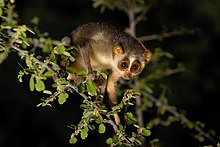Loris (genus)
| Slender lorises | |
|---|---|
 |
|
| Gray slender loris (Loris lydekkerianus) | |
| Scientific classification | |
| Kingdom: | Animalia |
| Phylum: | Chordata |
| Clade: | Synapsida |
| Class: | Mammalia |
| Order: | Primates |
| Suborder: | Strepsirrhini |
| Family: | Lorisidae |
| Subfamily: | Lorinae |
| Genus: |
Loris É. Geoffroy, 1796 |
| Type species | |
|
Loris tardigradus É. Geoffroy, 1758 |
|
| Species | |
| Synonyms | |
|
|
Slender lorises (Loris) are a genus of loris native to India and Sri Lanka. The slender loris spends most of its life in trees (arboreal), traveling along the top of branches with slow and precise movements. It is found in tropical rainforests, scrub forest, semi deciduous forest and swamps. The species have lifespans of 15 years and are nocturnal. Slender lorises generally feed on insects, reptiles, shoots of plants and fruits. Locally, they are known as "Devanga Pilli" in Telugu, kaadu paapa ("forest baby") in Kannada, kutti thevangu in Tamil and Malayalam, and unahapuluwa in Sri Lanka.
There are two known species:
According to biologists, poaching activity has led to the steady decline of the species in Tamil Nadu. Native people have always believed that all parts of the slender loris have some medicinal or magical powers. This has contributed greatly to the decline of the slender loris. In addition, slender lorises are illegally smuggled to supply a growing exotic pet trade. Along the western region of Tamil Nadu, there is a vigorous clampdown on illegal poaching of slender lorises.
Destruction of tropical rain forest habitat is also contributing to declines in population.
Red slender loris
Grey slender loris
Red slender loris
The red slender loris favors lowland rainforests (up to 700 m in altitude), tropical rainforests and inter-monsoon forests of the south western wet-zone of Sri Lanka. Masmullah Proposed Forest Reserve harbors one of few remaining red slender loris populations, and is considered a biodiversity hotspot. The most common plant species eaten was Humboldtia laurifolia, occurring at 676 trees/ha, with overall density at 1077 trees/ha. Humboldtia laurifolia is vulnerable and has a mutualistic relationship with ants, providing abundant food for lorises.[5] Reports from the 1960s suggest that it once also occurred in the coastal zone, however it is now thought to be extinct there.
...
Wikipedia
